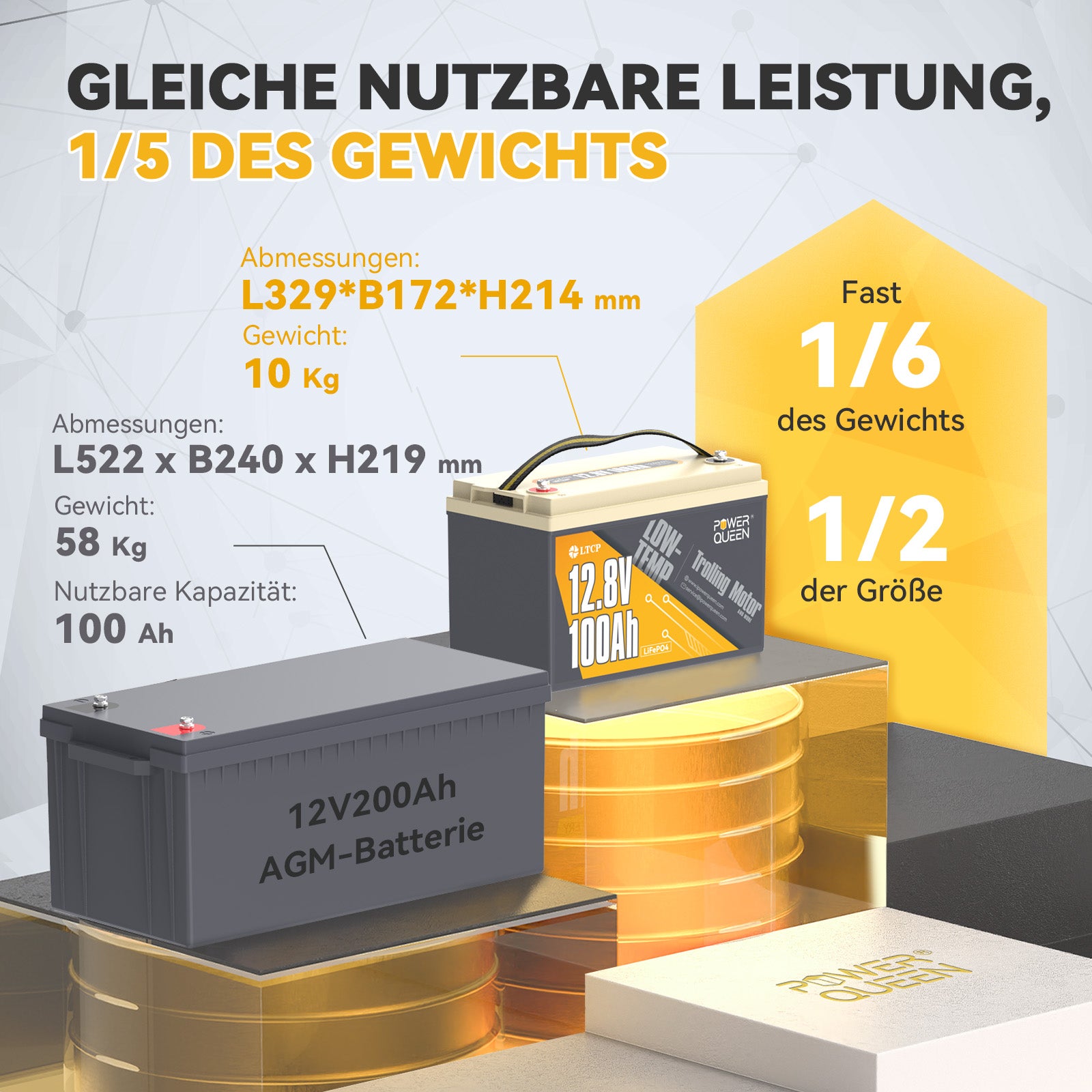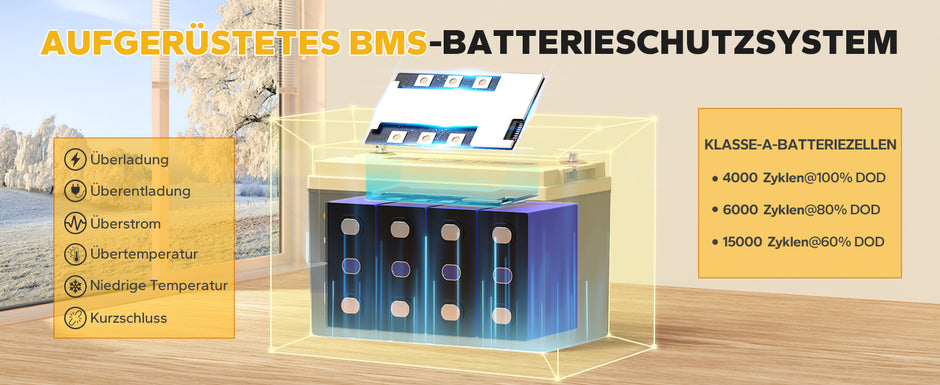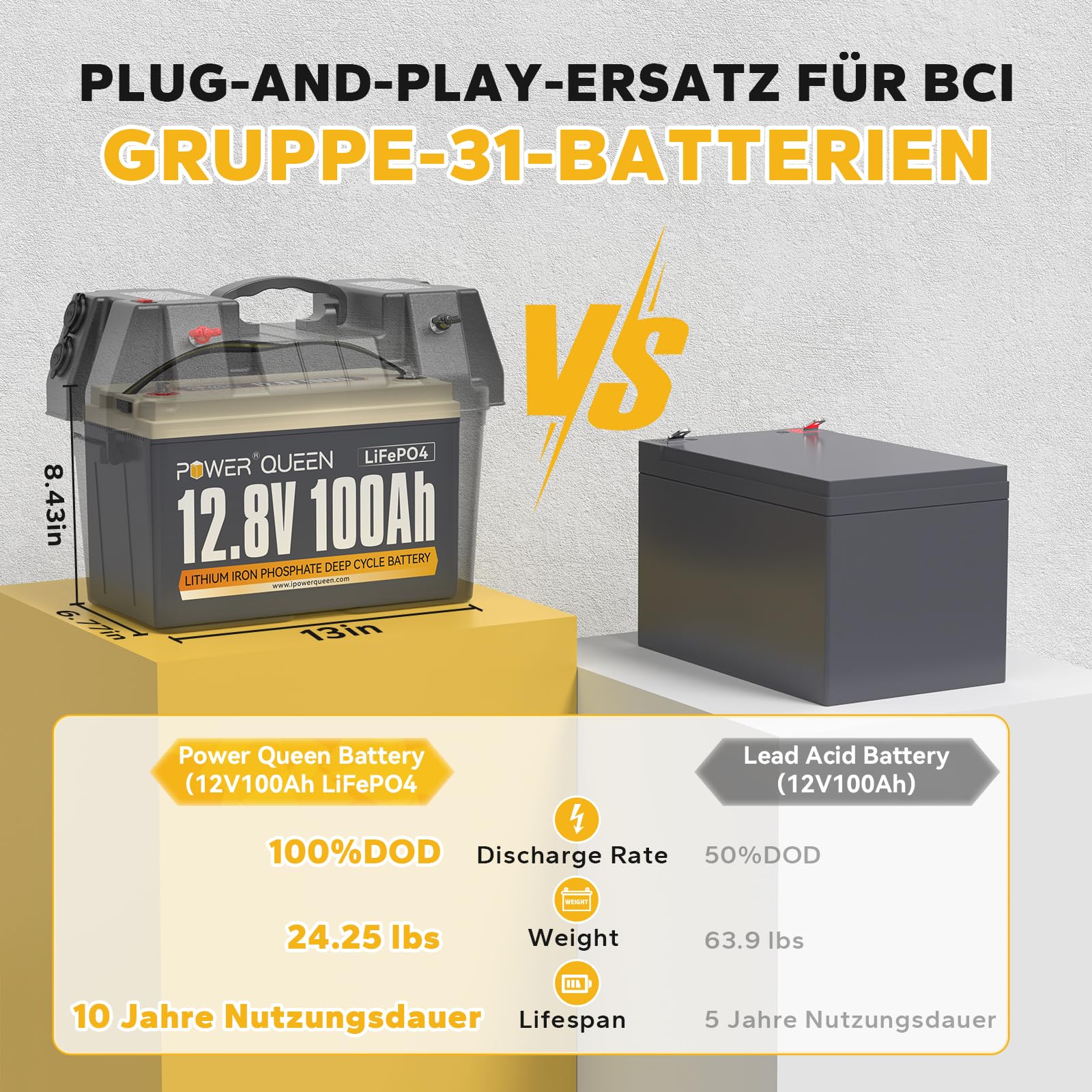![[Vollständige Anleitung] Was sind die verschiedenen Arten von Schiffsbatterien?](http://www.ipowerqueen.de/cdn/shop/articles/12.webp?crop=center&height=100&v=1715494613&width=1400)
[Complete instructions] What are the different types of ship batteries?
, From Sally Zhuang, 8 min reading time
Power Queen Energy for every generation - with sustainable and clean energy solutions create a better future for all families. Whether you supply your grandparents 'slow electric car, your parents' fishing boat, your motorhome or your children's electric scooters - we take care of the energy needs of each family member.
Show more >Contact us – your satisfaction is our motivation! Our dedicated team is happy to answer any questions, provide product information, or provide technical support and looks forward to hearing from you. Customer Service: service.de@ipowerqueen.com
Show more >Power Queen not only offers high-quality lithium batteries, but also a living community. Do not miss any news, special offers and tips for using our products. Become part of the Power Queen family and benefit from inspiring content and direct interaction with our team.
Show more >The stories of our customers have helped Power Queen to grow enormous growth and strength. We work with various customers to bring sustainable energy to every house and to master the challenges of energy supply in difficult environments. Their stories started when they met Power Queen ...
Show more >On this page you will find valuable insights from other users who help you make the right decision. We hope that you will take part in the evaluation and help us to improve our commitment to excellence with your feedback!
Show more >In our battery science area, we offer you exciting insights and well-founded information about lithium batteries. Learn more about innovative applications and tips for the optimal use of your batteries. Our goal is to convey the necessary knowledge to you so that you can fully exploit the advantages of our products.
Show more >Users report on their experiences and test results from practice and give them an insight into the performance and reliability of our lithium batteries. Find out how our batteries are used in everyday life and convince yourself of your quality and efficiency.
Show more >In our shopping guide, we help you to understand the differences between our different battery models and make the best choice for your needs. You are well informed with our detailed comparisons and expert recommendations.
Show more >In this area we present exciting feedback and experiences of users who have used our lithium batteries for their DIY electricity projects. Find out how customers implemented your individual projects after the purchase and what advantages you have gained through the use of our batteries.
Show more >A life full of energy: influencers report! Find out how these creative influencers use our lithium batteries to support their adventures, be it when traveling, camping or creative projects. Let yourself be infected by your innovative ideas and passion for sustainable energy.
Show more >![[Vollständige Anleitung] Was sind die verschiedenen Arten von Schiffsbatterien?](http://www.ipowerqueen.de/cdn/shop/articles/12.webp?crop=center&height=100&v=1715494613&width=1400)
, From Sally Zhuang, 8 min reading time
There are four main chemistries of marine batteries: lithium, gel cell, AGM (absorbed glass mat), and wet cell. While lithium batteries are different from the others, all others are lead-acid. In terms of intended use, there are three main categories: starter, deep cycle, and dual-purpose. Given the variety of options available, choosing the right marine battery can be overwhelming.
But don't worry, we're here to guide you through the process. In the following sections, we'll break down the different types of marine batteries and give you the knowledge you need to make an informed decision before you embark on your battery-buying journey.
There are three main types of marine batteries: starter, deep-cycle, and dual-purpose. Each type is designed to perform a specific function.
Starter battery:Marine starter/cranking batteries are specifically designed to deliver a high burst of power to start the boat's engine. They feature a large number of thin lead plates, providing a large surface area for the chemical reactions that generate electricity. These batteries are not suitable for deep discharge cycles, but rather for short, high-energy bursts. Marine starter batteries are typically used in boats that have a separate battery for starting the engine and a separate battery for powering accessories.
Deep Cycle:Deep cycle marine batteries Deep-cycle batteries, on the other hand, are designed to provide a stable and reliable power source over an extended period of time. They are made of thicker lead plates, which allow for a slower discharge rate and a longer lifespan compared to starter batteries. Deep-cycle batteries are typically used for trolling motors, on-board electronics, and powering large electrical devices over extended periods, such as overnight camping trips on a boat. These batteries are designed to withstand repeated and deep discharges without significant damage. Currently all batteries from Power Queen in deep cycle mode.

Dual Purpose:Dual-purpose marine batteries are a combination of start-up and deep-cycle Batteries. They are designed to provide both the high cranking power required to start an engine and high cycling capability for powering onboard accessories. Dual-purpose Batteries are designed with a balance between thin starter battery plates and thicker deep-cycle plates. While they don't outperform dedicated batteries in either starting or deep-cycle performance, they offer a compromise for boats with limited battery space. Dual-Purpose Batteries are typically used in smaller boats or applications where a single battery must perform both starting and deep cycle duties.
Due to their chemistry, different types of marine Deep Cycle Batteries are available. Common types include lead-acid batteries and lithium (LiFePO4) Batteries.
Lead-acid batteries are the most commonly used type in marine applications. These batteries use a liquid electrolyte and are available in several different versions, including lead-acid batteries and AGM (absorbed glass mat) batteries.
Lead-acid batteries are one of the oldest types of marine batteries and consist of lead plates and acid. Flooded lead-acid (FLA) batteries require regular water addition, making them less suitable for marine use. A major disadvantage of lead-acid batteries is their bulkiness and weight, with each battery weighing approximately 80 pounds. This makes them unwieldy and increases the weight of the boat. In addition, lead-acid batteries have the slowest charging time compared to other types.
AGM and gel lead-acid batteries offer some improvements over FLA batteries. They have a lower self-discharge rate and are leak-proof. However, they still have a low capacity-to-size ratio, meaning they don't offer as much power in a compact size.
Despite these drawbacks, some people choose lead-acid batteries, especially FLA batteries, due to their affordability. However, the lower price is offset by the need for frequent battery replacement. Most lead-acid marine batteries typically only last about 2 to 4 years.
Another type of deep-cycle marine battery is the lithium battery, which uses a different chemistry known as lithium iron phosphate (LiFePO4). This type of battery solves the problems commonly encountered with lead-acid batteries. LiFePO4 batteries are smaller, lighter, and have a longer lifespan. They also charge faster.
Advantages of using lithium marine batteries:
Lighter in weight
By switching to lithium marine batteries, you can reduce the weight of your boat battery by up to 70%.
A conventional 12V 100Ah lead-acid battery weighs about 60 to 70 pounds, while a Power Queen 12V 100Ah battery weighs only 19 pounds.

Maintenance-free
A key advantage of lithium batteries is their maintenance-free nature. Tired of adding water to your lead-acid battery? LiFePO4 batteries don't leak and require no maintenance, allowing you to spend more time enjoying your boating activities. Additionally, lithium batteries deliver consistent power even when partially discharged. This means your trolling motor and other equipment will perform just as well at the end of the day as they did at the beginning.
Security
Lead-acid batteries can be susceptible to internal short circuits, damage from temperature fluctuations, and various problems caused by incorrect charging methods. It is worth mentioning that lead-acid batteries do not have a built-in battery management system (BMS) that monitors their performance and provides additional protection measures.
On the other hand, LiFePO4 lithium batteries equipped with a BMS, which provides protection against short circuits, overvoltage, overcurrent, deep discharge, overheating, and even low temperatures. This feature increases safety and ensures the longevity of the battery.

100% depth of discharge
Depth of discharge (DOD) refers to the amount of a battery's capacity that has been consumed or discharged relative to its total capacity. It is typically expressed as a percentage. For example, a battery with a DOD of 50% has discharged half of its total capacity.
DOD is an important consideration for battery users as it affects the performance and lifespan of a battery.In general, deeper discharge levels can lead to increased battery wear and shorten its overall lifespan. Batteries regularly discharged to a higher DOD may have a shorter lifespan than batteries discharged to a lower DOD.
Unlike lead-acid batteries, lithium batteries can be discharged to less than 50%. Power Queen's LiFePO4 batteries have a depth of discharge (DOD) of up to 100% without damage.
This gives you more flexibility in using the battery capacity without having to worry about possible damage.
10-year lifespan
Lead-acid batteries typically last 3 to 5 years under normal use. However, their lifespan can be significantly reduced if they are frequently deeply discharged or exposed to harsh conditions. Gel batteries may have a slightly longer lifespan than lead-acid batteries.
On the other hand, LiFePO4 Batteries With a life cycle of 4000-15000, they have a service life of approximately 10 years or more with proper care and maintenance. They are designed to handle a greater number of charge and discharge cycles without significantly affecting their capacity. This makes them more durable and suitable for applications requiring frequent cycling, such as deep-cycle marine battery applications.

If you think long term, choosing a LiFePO4 Batteries are a worthwhile investment.
1. Can I use a marine battery in a car?
Yes, you can use a marine battery in a car, but it may not be the most ideal choice. Marine batteries are designed to power marine applications, such as powering trolling motors or powering electronics on boats. They are typically deep-cycle batteries that can handle frequent charge and discharge cycles.
Car batteries, on the other hand, are designed to deliver a high burst of power to start the engine and provide only limited power to the car's electrical systems. They are often referred to as starter batteries or starter motor batteries.
While a marine battery can technically be used in a car, it may not be as effective at providing the power needed for continuous engine starting. Car batteries are specifically designed for reliable starting, so it's generally recommended to use a dedicated car battery for automotive applications.
2. Can I charge marine batteries with trickle chargers?
Yes, you can charge a marine battery with a maintenance charger. Maintenance chargers are designed to supply a small, continuous current to a battery, slowly charging it over time. They are typically used to maintain a charge in batteries during storage or when the batteries are not in use.
However, it's important to note that trickle chargers are not recommended for quickly charging completely discharged marine batteries. In such cases, it's better to use a suitable charger with higher voltage and current ratings to ensure faster and more efficient charging.
If you have a LiFePO4 lithium Use the battery, find out how to use a LiFePO4 Charge battery.
3.Can I charge my marine battery while it is still connected to the boat?
It is generally recommended to disconnect all devices or accessories from the battery before charging. This ensures that the charging process is not interrupted and allows for accurate monitoring of the charging progress.
Choosing the right marine battery is crucial for your boat's reliable power supply. Are you noticing that your marine batteries' performance is decreasing? It's time to replace them with a new one. Check out Power Queen We offer Class A LiFePO4 batteries with more than 4000 cycles. If you have any questions, please contact service.de@ipowerqueen.com.
Free shipping within the EU🚛 (except islands)
Reply within 24 hours🤝
5-year warranty👑
Free shipping within the EU🚛 (except islands)
Reply within 24 hours🤝
5-year warranty👑


